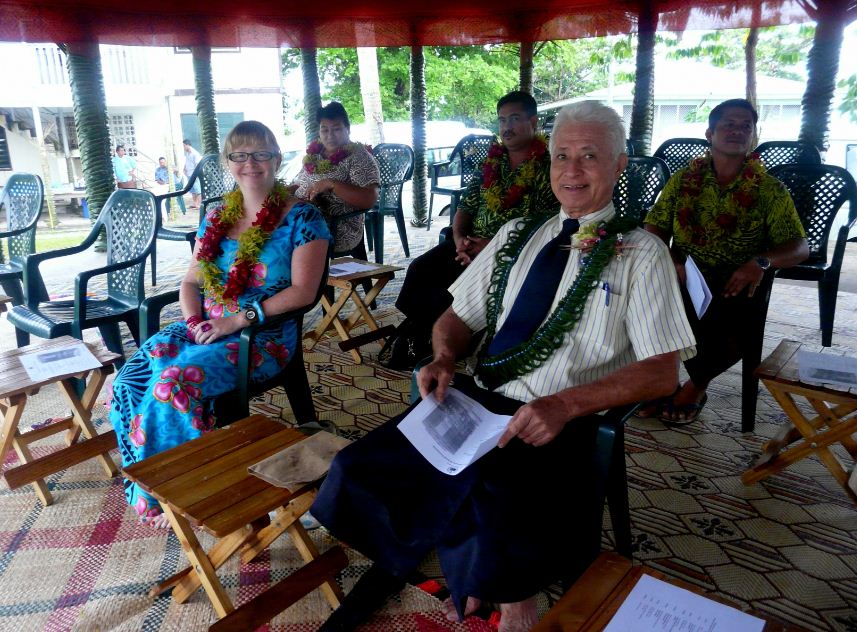
With disability students and other Australian volunteers in front of the painting done by the students.
This week is a very busy week in Samoa in the disability community. We are celebrating the International Day of Persons with Disabilities (IDPwD), with a whole week of events. An Opening Ceremony was held yesterday on the island of Savai’i. Generally, official ceremonies and events are held in the capital Apia, on the island of ‘Upolu. However, the organising committee wanted to ensure inclusion of persons with disabilities in Savai’i for this year’s ceremony, and so it was held in the village of Salealoga. It was well attended, by disability NGOs and service providers, as well as students and staff of special schools from around Samoa. The President of NOLA (Nuanua O le Alofa), a disability advocacy organisation based in Apia, gave an excellent speech about the need of inclusion of persons with disabilities in all fields of life in Samoa. This was in keeping with this year’s IDPwD theme, ‘Break barriers, open doors: to realise an inclusive society for all’. There was a speech competition for young school students, in which they had to speak on breaking barriers for inclusion of PwD. That was followed by a debate between students of Amoa College and the Australia-Pacific Technical College (APTC), who debated on whether PwD should be treated the same as other people. The debate demonstrated a need for education about PwD, including an understanding of correct terminology (e.g. to not refer to persons without disabilities as ‘normal’ compared to PwD). Maiava Toma, the Ombudsman, and I attended, and were seated in the Officials’ fale overseeing the proceedings. Maiava was appointed to present the prizes for the speech and debating competitions, and had generously donated the first prize for the speech competition.
Other events include the painting of two banners, one on ‘Upolu and one on Savai’i, in order to capture inclusion of PwD and to showcase their abilities. NOLA is conducted a training session for people in Savai’i on the Convention of the Rights of Persons with Disabilities (CRPD). NOLA also held a disability access audit of the main bus station area in central Apia, which I participated in, as an assessor and also a guide for one of the visually impaired NOLA staff members. We determined that the bus station area has a long way to go before it is accessible, with work such as footpath repair needed, as well as a clear pedestrian crossing with identifying sounds and textiles for persons with disabilities. The Ministry of Women, Community and Social Development (the focal point ministry for disability issues) ran a workshop on Community Based Rehabilitation, in which we learned about the different services provided by some organisations (such as inclusive CBR for children and adults) and some government departments (such as health and justice). Some more information on these events can be found in the news article I wrote that was published early in the week in some Samoan newspapers.
Samoa is working towards ratification of the CRPD. There was hope that it would be ratified at the 2013 General Assembly meeting in September, but this did not happen. Therefore, the hope is that Samoa will ratify at the 2014 GA meeting. Disability rights is one of the biggest human rights issues in Samoa, as there are many people with disabilities here. The 2011 census counted over 4000 people with disabilities in a total population of 187,000. Of course, it must be kept in mind that a census may not necessarily capture all PwD, as some people may not self-identify as having a disability, or may not participate in the census. The majority of PwD live in rural areas either on ‘Upolu or Savai’i.
While the single biggest cause of disability in Samoa is falling out of coconut trees, other causes include diabetes, which often goes untreated here, and thus can result in loss of vision or feet. There are two reasons for this lack of treatment: the first is cultural, namely that if a person does not exhibit obvious physical signs, then Samoans do not believe there is an illness to be treated. The second is resource-related, in that the medication to treat diabetes is not available (some people have to go to New Zealand or Australia for treatment, but obviously this is not a cost that many Samoans can afford). This highlights the need for a broad approach to disability rights, which incorporates prevention (healthcare availability and education) as well as treatment and provision of services.
The government is approaching ratification of the CRPD from a different perspective to the usual approach for treaty ratification. The CRPD is a very complex treaty, quite distinct from any other human rights instrument. In addition, it is a treaty that will cost to implement, much more so than other international instruments. The government of Samoa has taken the controversial action of undertaking a cost-benefit analysis of implementation of the CRPD. This is controversial because PwD argue that you cannot put a price on the ability to live your life freely and inclusively. In addition, the Samoa Law Reform Commission will be conducting a CRPD legislative compliance review in 2014. The NHRI will take part in the working group to participate, as the NHRI’s mandate includes assessing legislation for compliance with human rights. As you can see, there is a lot going on with disability rights in Samoa at the moment, and it will continue to gain momentum over the coming years, hopefully resulting in CRPD ratification in 2014.


